When you decide to bring your product idea to life, questions are bound to appear everywhere. How can you begin the process of product development? Who should you work with? How much will it cost?
One of the toughest questions to answer is which type of software contract you should go for when working with a developer company.
In the product development industry, there are two major pricing models: Time and Materials and Fixed Price. Both have pros and cons, and choosing the right one can seem tricky. So, to help you decide, we listed all of the specific elements and used specific cases to illustrate the advantages and disadvantages of each pricing model.
Fixed price model
What is a fixed price contract?
In a fixed price model, the project budget is set. You (the client) pay a fixed amount of money to create a product, and the amount you pay is based on two main factors:
- the extent of the project (i.e., the number and complexity of the features
- the deadline you set
This type of contract allows you to pay out a single price for everything: features, materials, and bug fixing.
To efficiently work in the fixed model, the end product needs to be very well-defined down to every last detail. This means that the planning phase will likely take up much more time compared to other projects.
You also need a clear idea of what you want to build, including the capability and performance of the final software. Pivoting and iteration usually do not fit within the budget.
Fixed price contracts pros and cons
Fixed price benefits
Finalized cost, low financial risk. After the project cost is set in the contract, you will know exactly how much you’ll pay. The software company cannot overcharge you without prior notice. With this contract model, the risk of overspending your budget is basically zero.
Fixed deadline. With a final scope and detailed features, the development team can better estimate the timeline for the project. Based upon that, they can come up with a clear plan and definite deadlines.
Easy-to-follow development schedule. You’ll know which features will be implemented at any given point during the project. You’ll also be able to tell if there’s a delay in the delivery.
No management needed from the client. Since the project details are all set, you can hand over project management responsibilities to the developer team. There’s no need for continuous supervision from your side so you can keep your participation to a minimum.
Fixed price disadvantages
Long planning phase. If you find yourself in a time crunch to deliver your product, this contract model is not for you. To be able to estimate accurately, the software company needs to plan features in thorough detail, and this can take weeks, or even months, to define.
Inflexible process. After you sign the contract, there is no room for changing or adding features. Let’s say that the market need changes and a feature becomes unnecessary or a new feature is needed. You won’t be able to adjust the scope of the project without negotiating every new feature and going through the planning process again. This can result in a serious delay in the delivery of the product.
Not suitable for complex projects. With smaller projects, the fixed price model works well. However, if your product is more complex ,like an e-commerce website or a multi-platform mobile app, the fixed model will be too rigid. Products with complex functions, dependencies, and long implementation need constant review, modification, and flexibility.
Miscommunication risks. To work well in a fixed price model, clear and straightforward communication is a must. If you miss a detail or the project specifications aren’t clear, you can easily receive something different than what you expected.
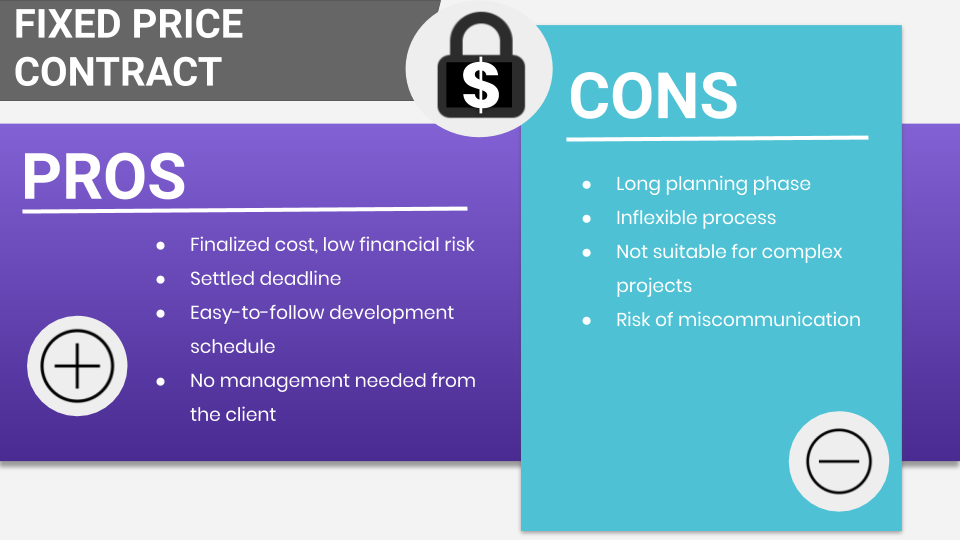
The fixed price model as a developer company
When you choose the fixed price model, it puts the developer under a lot of pressure. Estimating the necessary time to develop a feature is tough, as you never know what technical difficulties may arise on the way. Of course, there are “boxed features” like logins or dashboards, but since we’re talking about custom software development, custom parts will and should turn up.
Also, accurately planning a product in detail that doesn’t yet exist is almost impossible. That’s why software companies usually overestimate the time needed to deliver, and as a client you end up paying a lot more as a result.
Even worse, since the developer company isn’t paid for features that come up during the development, they may rush the work and deliver mediocre quality.
It’s clear that this model isn’t necessarily the most advantageous for the client. It runs the risk of resulting in a low-quality product that has lost a chance to be improved on the conceptual level during development.
When should you choose the fixed price model?
- If you know exactly what you’d like to build
- If your project is small with limited features
- If you are making an MVP
- For shorter projects that take about 3-5 months
- When you have a definite deadline
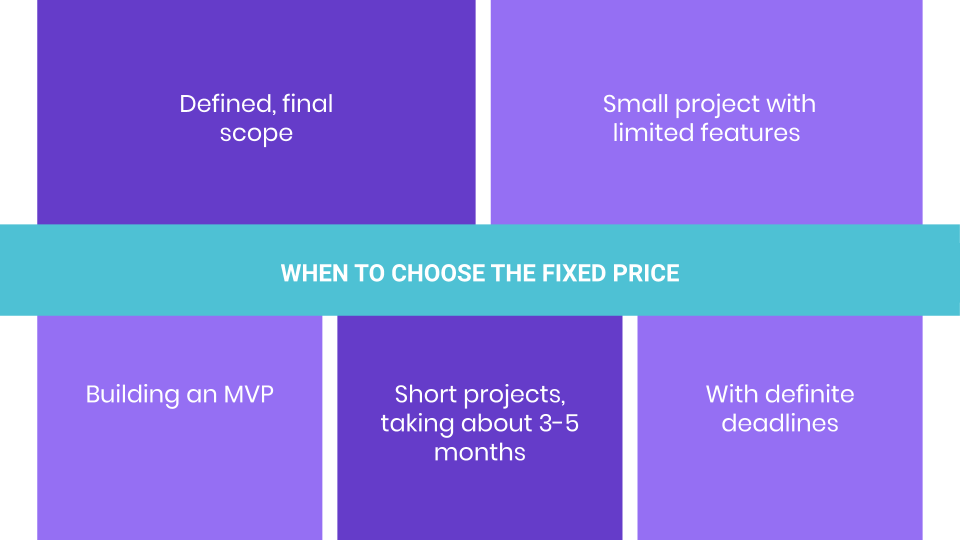
All in all, the fixed price model has its benefits. However, it is not the ideal option when dealing with software development. Creating software that users love takes continuous testing and iteration, and there’s little to no room for experimentation when operating under a fixed price contract.
The t&m model
What is a time and materials contract?
With time & materials pricing, you pay for the real time spent on building the application. It’s a flexible solution which allows you to make changes to the product, alter priorities, shuffle features, pivot and react to market and user needs.
Time and materials pricing pros and cons
Time and materials pricing benefits
Easy project start. You don’t need a final, detailed product plan. You merely need to define the scope with the team and the minimum viable features to start the development.
Fast response to market changes. You’re able to make any change required to make the product a success. For example, let’s say you planned to integrate Facebook login to your application, but it turned out that your users do not use Facebook. You can leave out the feature and implement something more valuable for your users. There’s no need for negotiation or meticulous planning.
Dynamic work scope. With larger projects, the main priority is to have a general goal of what you want to achieve. Knowing exactly how the goal can be achieved is rarely known in the beginning. In our experience, for startups and SME it is better to make decisions throughout the process. This way the strategy and the product can evolve based on market feedback.
Practical testing of hypotheses. You can avoid building something nobody wants by creating a quick MVP and testing it out with real users. This allows you the opportunity to iterate the scope based on their feedback. With the fixed price model, the list of features is set in stone from the beginning, and there’s no room or flexibility for this kind of validation.
Product quality. Continuous iteration and user testing help to create a product that is as near to perfection as possible. With a high-quality software, your users will be much happier and much more likely to return to you.
Transparency. You will have access to as much information about the project as you want. We personally like to have regular planning meetings and product demos so that clients can keep track of the product’s progress. We also use our own project management tool where clients can follow the development process by task.
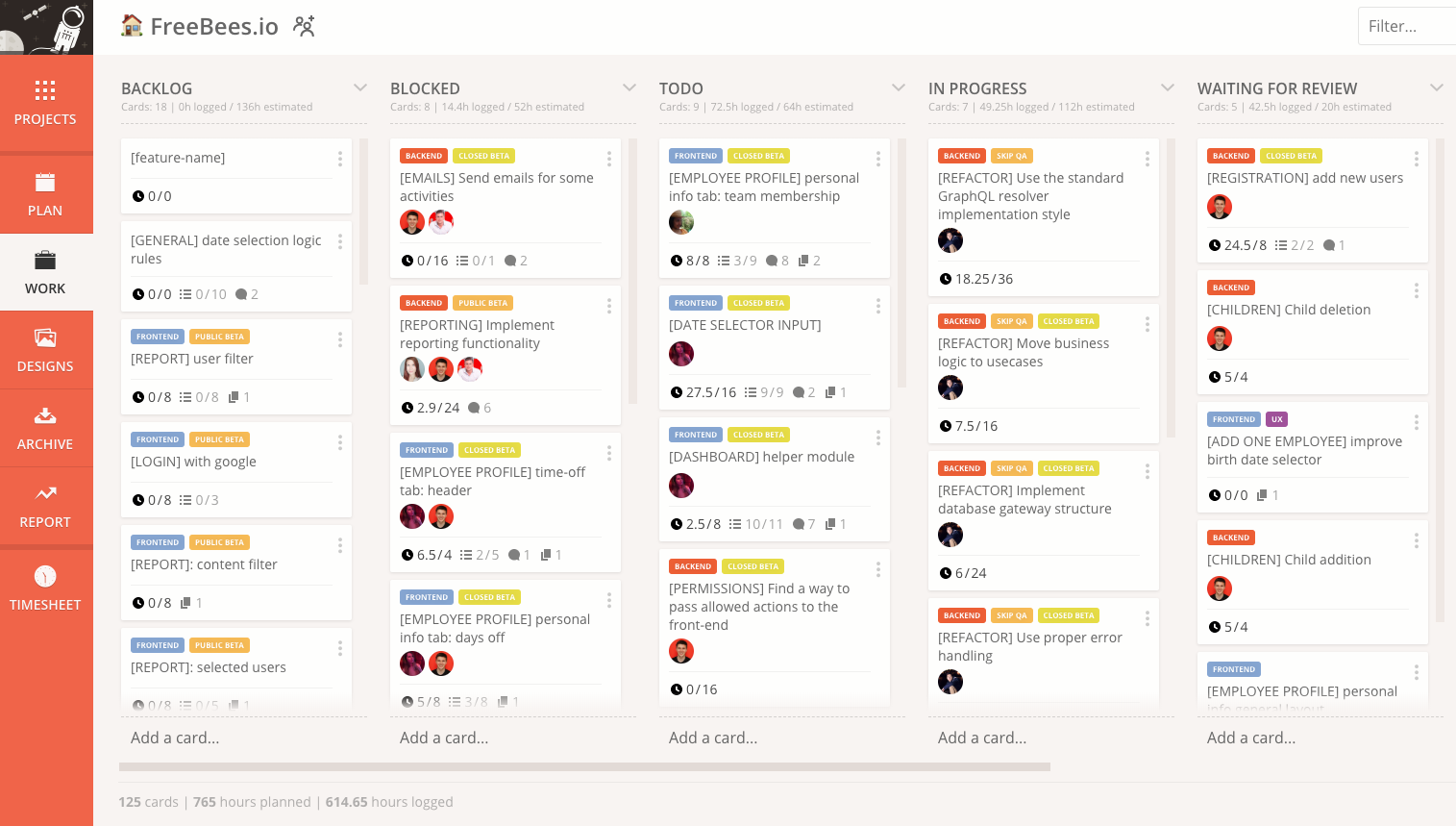
Easier to prioritize. Not sure which feature to start with or which will provide optimal value to users? Should you start with simple or more complex tasks? With the T&M contract, you have the room to experiment and change directions as many times as you need.
Time and materials disadvantages
Low budgeting control. Since the scope of the project is not defined in detail, you cannot know the exact final cost of the product will be. Only an approximate amount can be predicted based upon the estimated work hours.
Uncertain deadlines. As the project can change according to market needs, it’s quite hard to define an exact release date. That’s why setting milestones is so important for this kind of cooperation.
Deep involvement. This may not be a disadvantage if you have the time and commitment to build your product. However, if your time and your involvement are limited, it can result in delays. In this model, you have to be able to make decisions about the product regularly so the product team can move forward in the right direction.
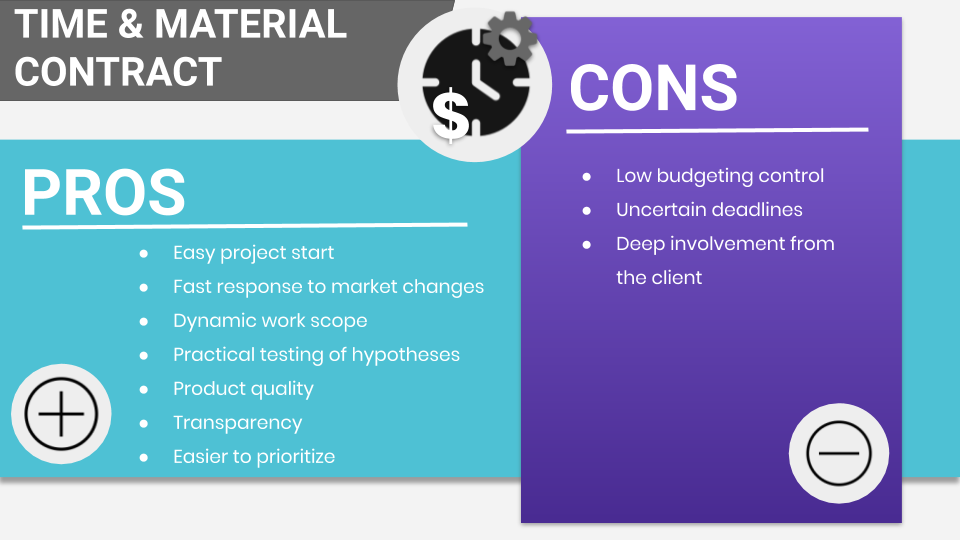
When should you choose the time and materials model?
- When you want to be sure you’re building something that has a market need
- If you plan to create something where user feedback is a must
- If the scope of your product is undefined and defining it would take more time than the development itself
- You have a raw or innovative product idea
- When you know very little or nothing about your target market
- When the quality of the product is more important than the cost
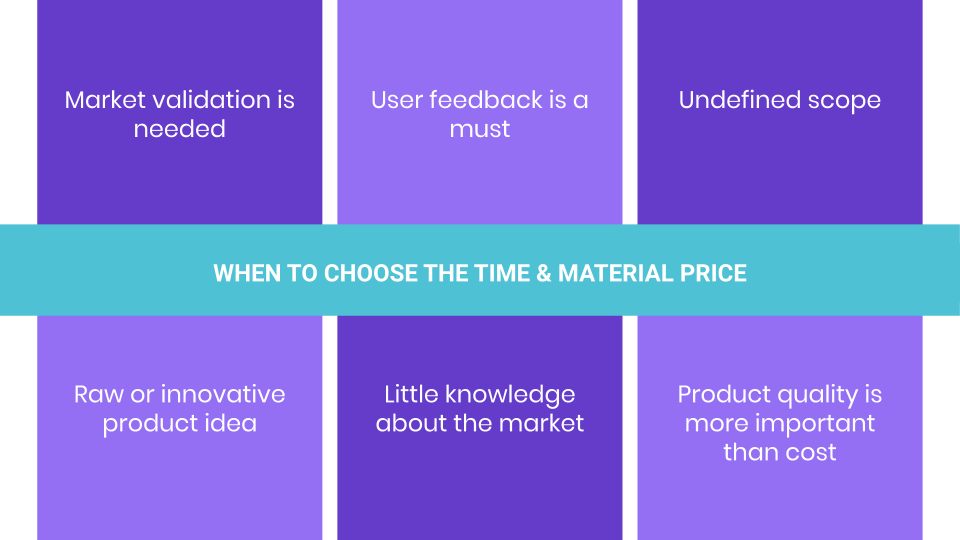
Conclusion of t&m model
If you have a large scope, know little about your target market, and you’d like to utilize the advantages of agile and lean development, T&M is your best bet.
In exchange for your time and money, T&M provides you the freedom to experiment with your features and find the best end result to wow your users.
It’s common knowledge that with T&M you won’t know the cost until the end of the project, but this is only half-true. Although you won’t know the exact cost, you’ll see a cost estimate or a price range based on the software company’s experience.
For example, when we create offers in time & materials, we set the price for both the best-case and the worst-case scenarios. This way the client will have a general idea of the cost if difficulties arise during the project.
Time & materials contract is based on 3 pillars between the client and the service provider: transparency, honest communication and trust. These take a lot of time to build and take even more effort to maintain. But in the end the situation is a win-win.
Questions to help decide
1. Do you know EXACTLY what you would like to build? If not, go with T&M. If so, you can choose the fixed-price model, but be sure to keep its downsides in mind.
2. How important is flexibility for you? If it’s essential, choose T&M. You can prioritize and adjust your project every few weeks. If it’s not so relevant, go with the fixed-price model and wait for the end result.
3. How important is managing the financial risk for you? If it’s crucial, go with the fixed model, but don’t forget about overestimation. If not, go with T&M and control precisely what you are developing.
Takeaways
A good client-provider relationship is the keystone of software development. Since money is often the #1 source of tension in a work agreement, a contract that is beneficial for both parties can lay a solid foundation for their cooperation. With the right type of contract, both parties can minimize risks and increase the chances of a positive outcome.
In the last 10 years, we’ve created over 150 products in both fixed and T&M models. Personally, we believe that the T&M model is the best way to go if you want a high-quality, lovable product.


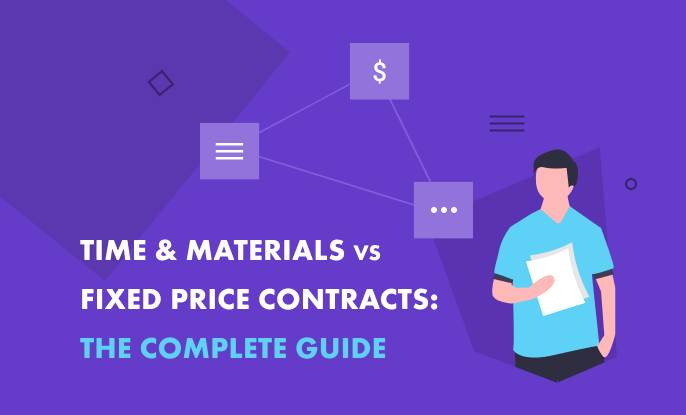
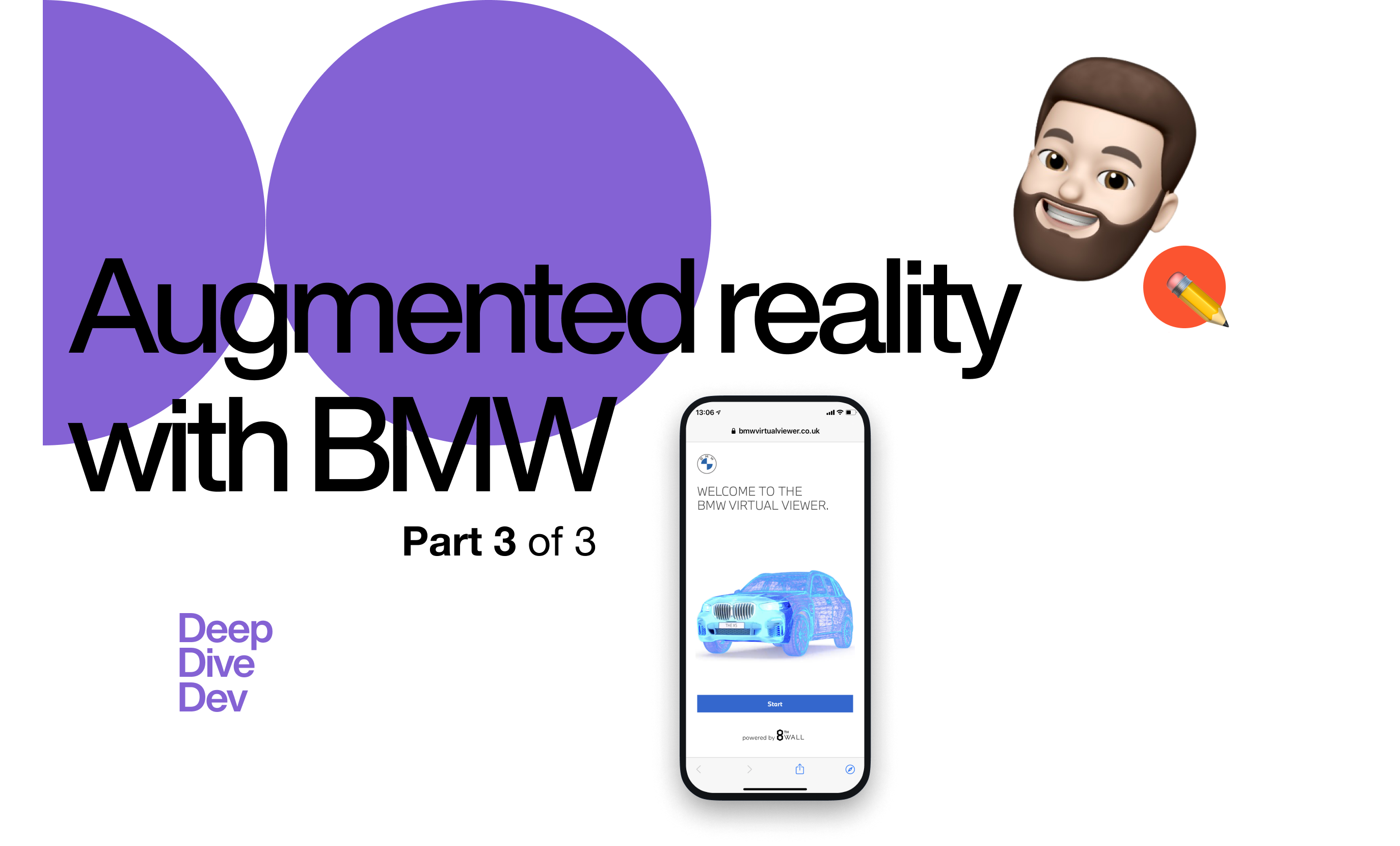
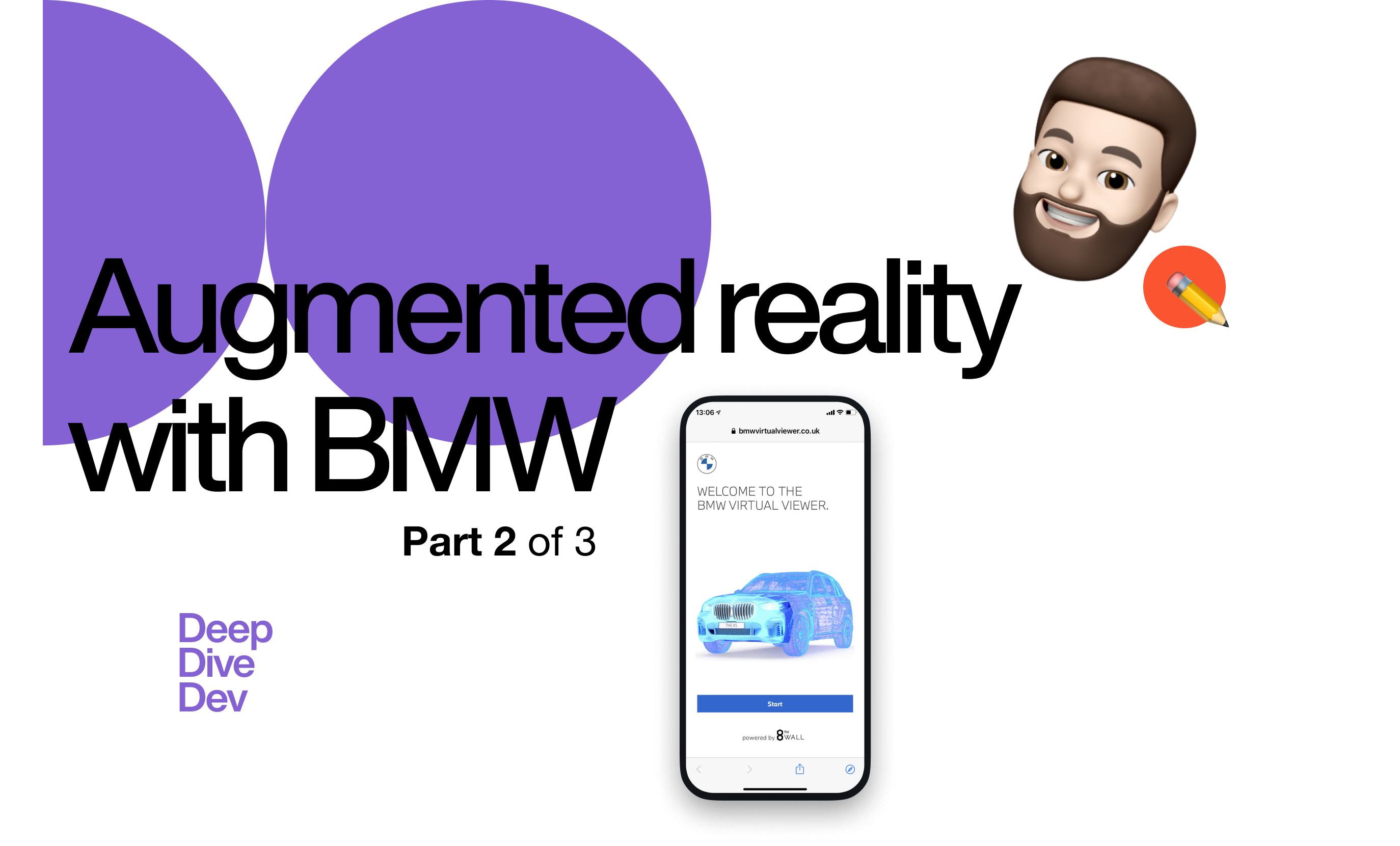

Have a look at our social media